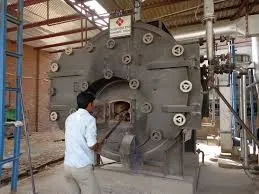
Sep . 21, 2024 18:47 Back to list
steam boiler pdf
Understanding Steam Boilers A Comprehensive Overview
Steam boilers are integral components in various industrial applications, providing a reliable source of steam for heating, power generation, and other processes. These devices operate by converting water into steam through the application of heat, which can be generated from various fuels, including natural gas, oil, coal, or through electricity. The efficiency and functionality of steam boilers are critical to the performance of systems in manufacturing, energy production, food processing, and more.
Principle of Operation
The fundamental operation of a steam boiler involves heating water in a closed vessel to generate steam. The process begins with water being fed into the boiler where it is heated by a burner or electrical heating element. As temperature rises, the water gradually transforms into steam, which increases in pressure. Once the steam reaches the desired pressure and temperature, it can be utilized for various applications, such as driving turbines for electricity generation or supplying heat for process operations.
Types of Steam Boilers
There are primarily two types of steam boilers fire-tube and water-tube boilers. Fire-tube boilers, which are commonly used in smaller applications, pass the hot gases produced by the combustion of fuel through tubes that are surrounded by water. The heat from the gases transfers to the water, creating steam. In contrast, water-tube boilers are designed for high-pressure applications and circulate water through a network of tubes that are heated externally by combustion gases. This design allows for faster steam production and higher pressure capabilities.
steam boiler pdf

Efficiency and Safety Considerations
The efficiency of a steam boiler is measured by its ability to convert fuel into steam with minimal energy loss. Advanced technologies and control systems have been developed to enhance boiler efficiency, utilizing methods like economizers and condensing heat exchangers to recover waste heat and improve overall performance.
Safety is paramount when operating steam boilers due to the high pressures and temperatures involved. Modern boilers are equipped with various safety features, such as pressure relief valves, automatic shut-off systems, and rigorous monitoring controls to prevent malfunctions and protect operators. Regular maintenance and inspections are crucial in ensuring safe and optimal performance.
Conclusion
In conclusion, steam boilers play a vital role in numerous industries, offering efficient and reliable steam generation. With advancements in technology, these systems continue to evolve, becoming more efficient and safe. Understanding the principles of steam boiler operation, types, efficiency, and safety measures is essential for industry professionals working with these systems. As industries strive for greater efficiency and sustainability, the importance of steam boilers in supporting these goals cannot be overstated. Proper selection, maintenance, and operation of steam boilers will remain critical to the success of various industrial applications.
-
Best Steam Boiler Design PDF Free Design Calculation & Diagram Downloads
NewsJun.10,2025
-
Hot Boiler Water Heater Efficient Heating Solutions for Home & Commercial Use
NewsJun.10,2025
-
Steam Boiler Safety Devices High-Quality Protection Valves
NewsJun.10,2025
-
Ultimate Steam Boiler Checklist for Safety & Efficiency
NewsJun.10,2025
-
Optimal Hot Water Boiler Temperature Setting Guide
NewsJun.10,2025
-
Effective Hot Water Boiler Chemical Treatment Protect & Maintain
NewsJun.09,2025
Related PRODUCTS






















